Herby Feta Lemon Chicken and Veggie Sheet Pan Dinner
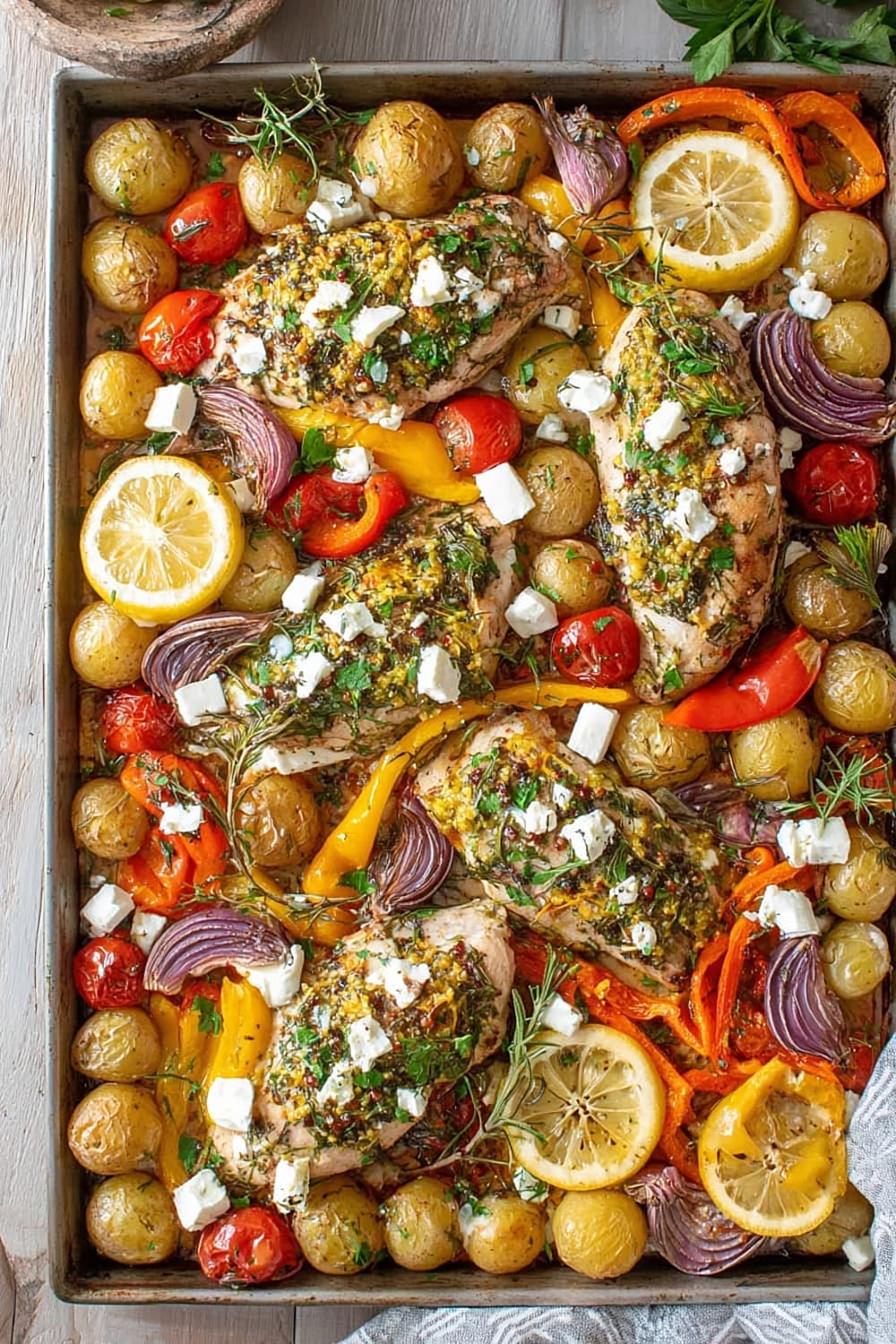
This sheet pan dinner is basically the superhero of weeknight meals – it swoops in to save you from decision fatigue while delivering maximum flavor with minimal effort.
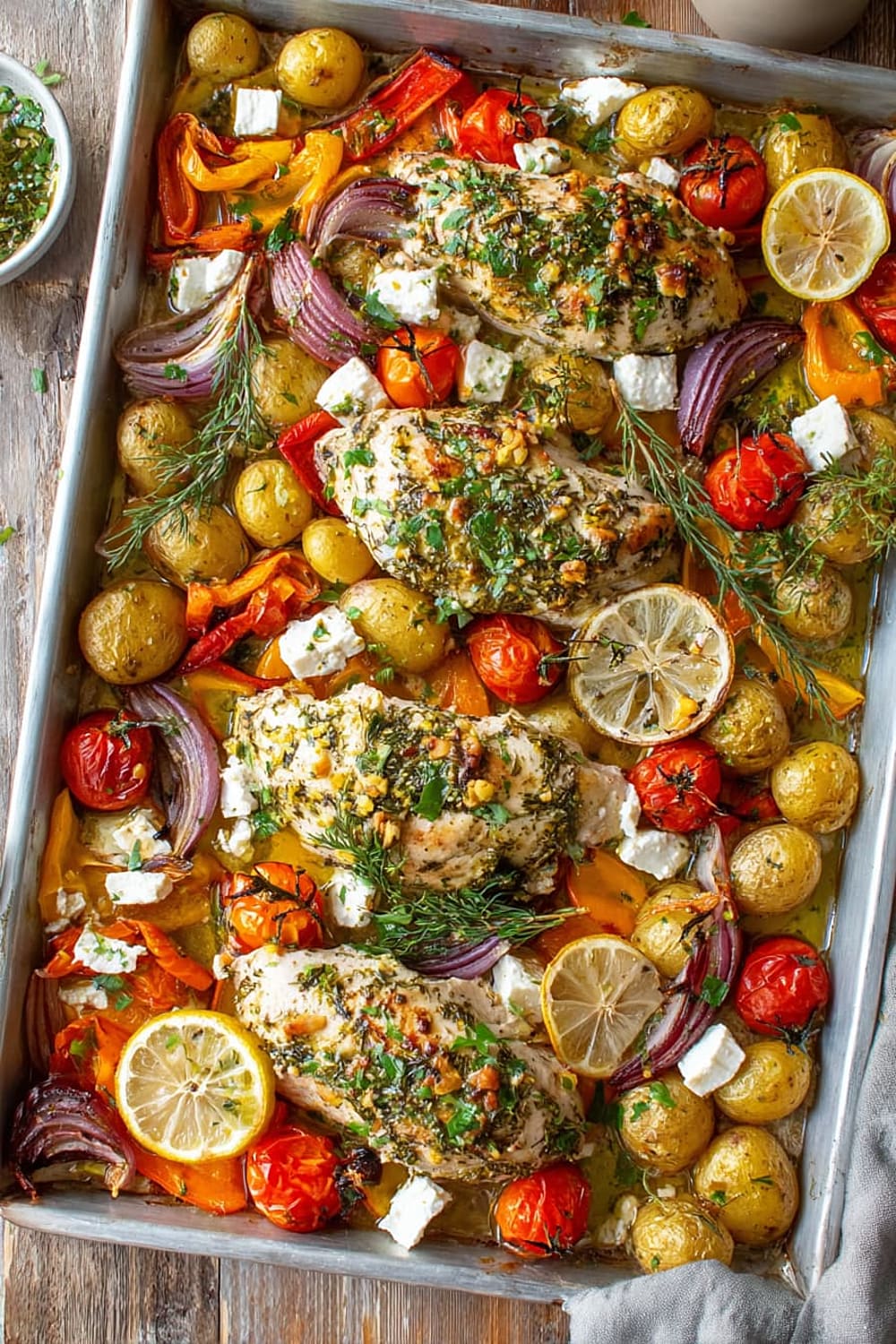
Picture this: golden chicken breast glazed with a Mediterranean herb marinade, nestled among caramelized baby potatoes and jammy cherry tomatoes, all perfumed with roasted lemon and finished with creamy chunks of feta that get just warm enough to be irresistible.
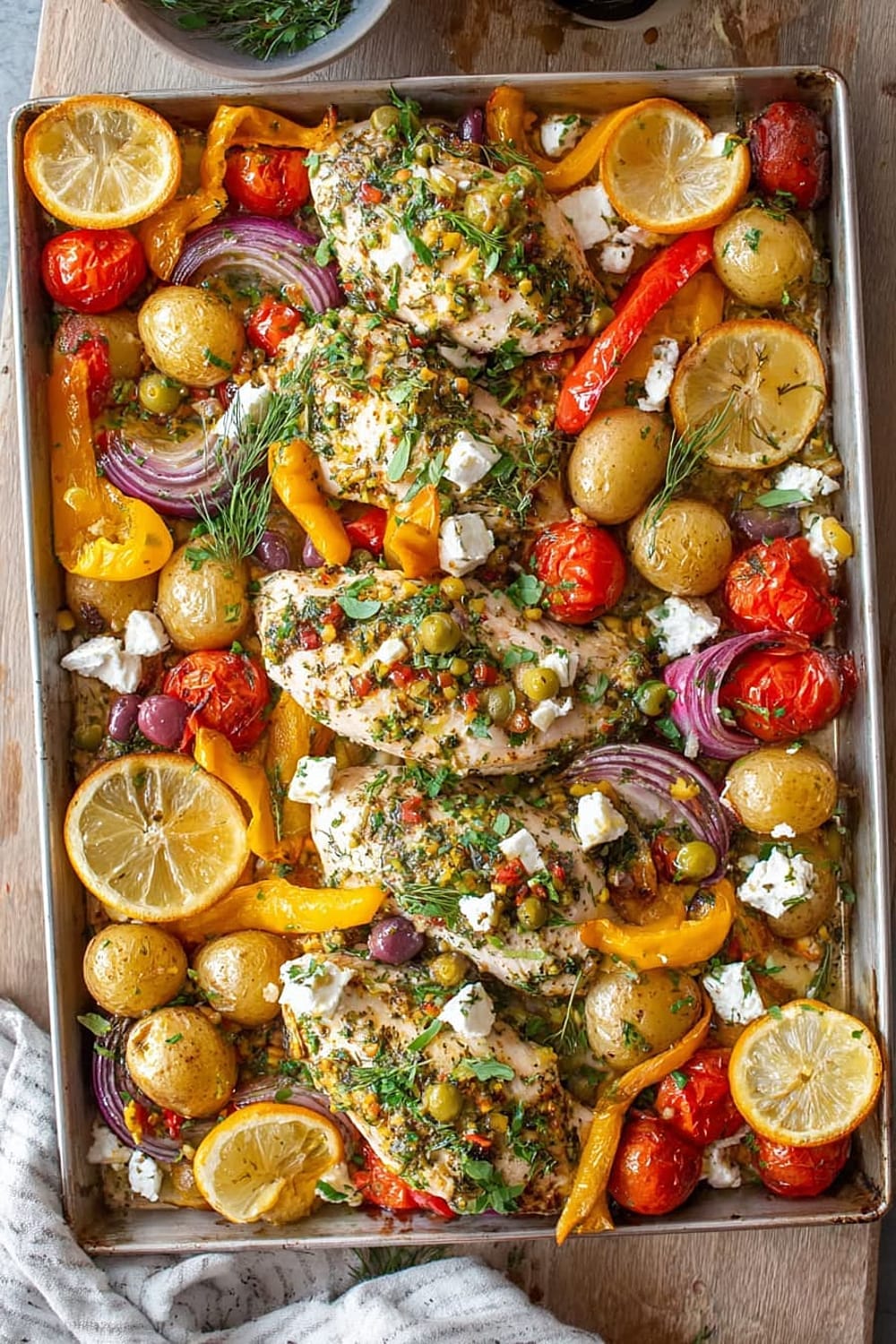
The magic happens when that herb-packed marinade – loaded with fresh parsley, dill, oregano, and rosemary – transforms ordinary chicken into something that tastes like it came from a Greek taverna.
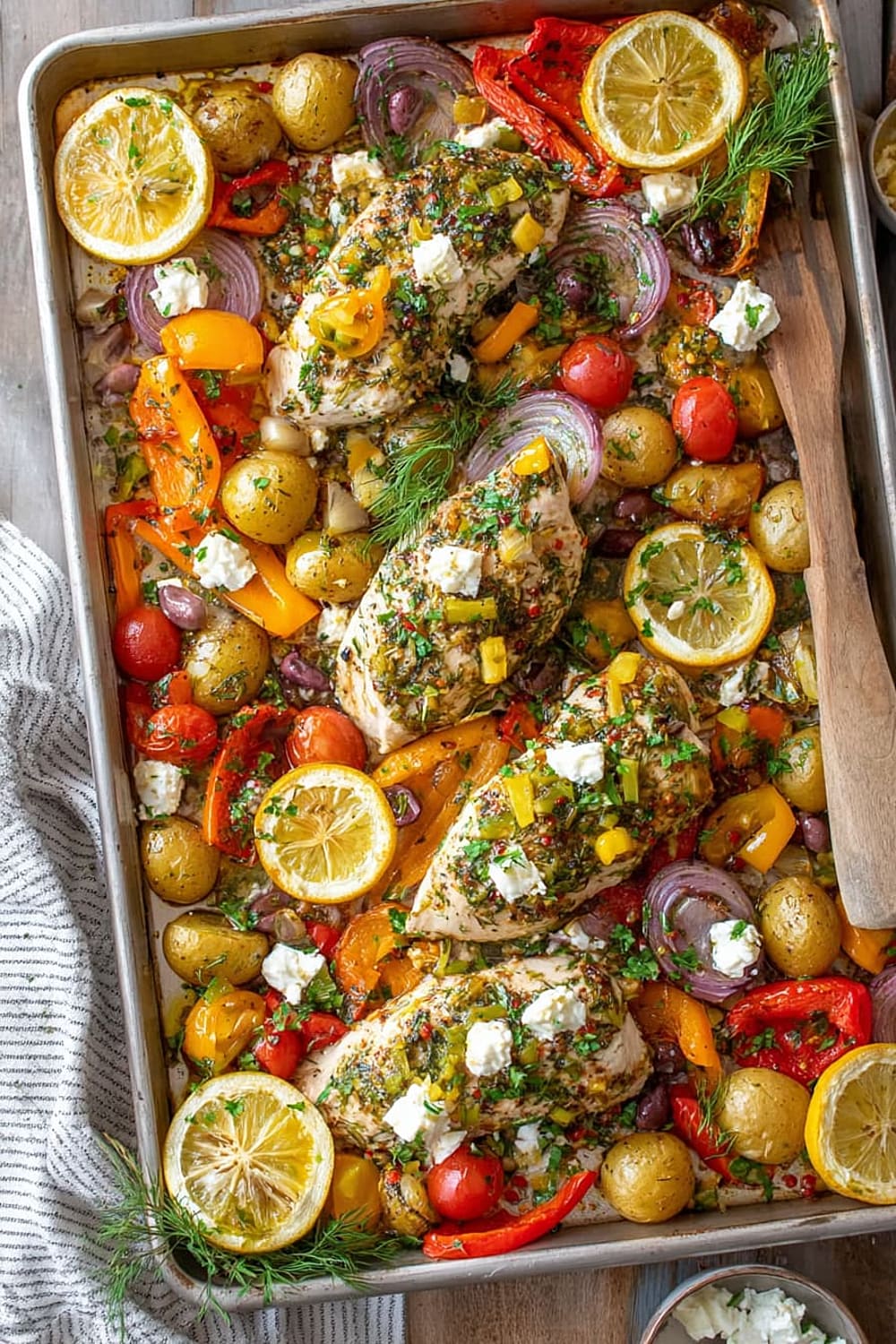
Everything cooks together on one pan, which means the vegetables soak up all those incredible flavors while you get to sit back and let the oven do the heavy lifting.
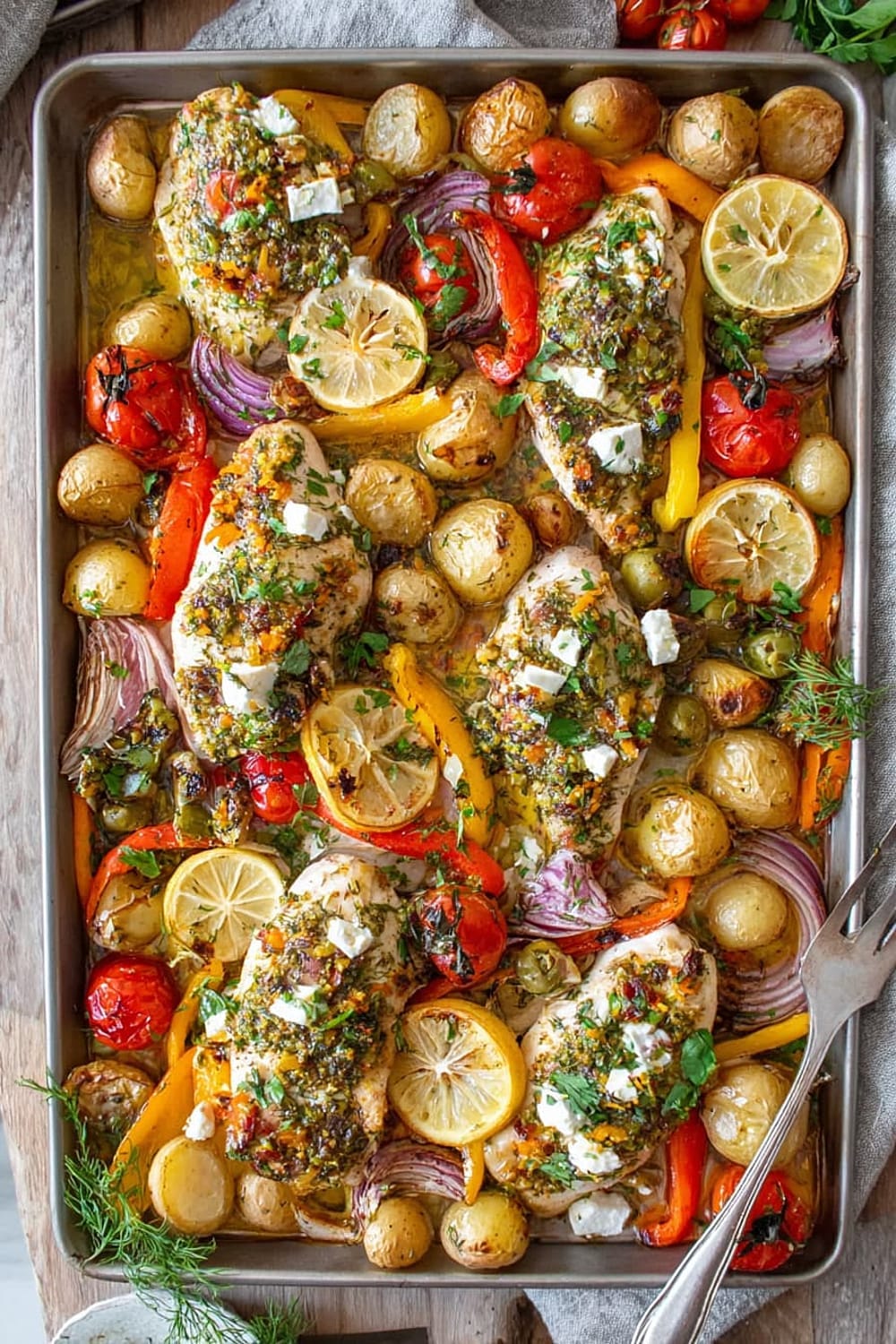
The result is a complete meal that’s both comforting and bright, with tender potatoes, perfectly cooked chicken, and vegetables that actually taste like they want to be eaten.
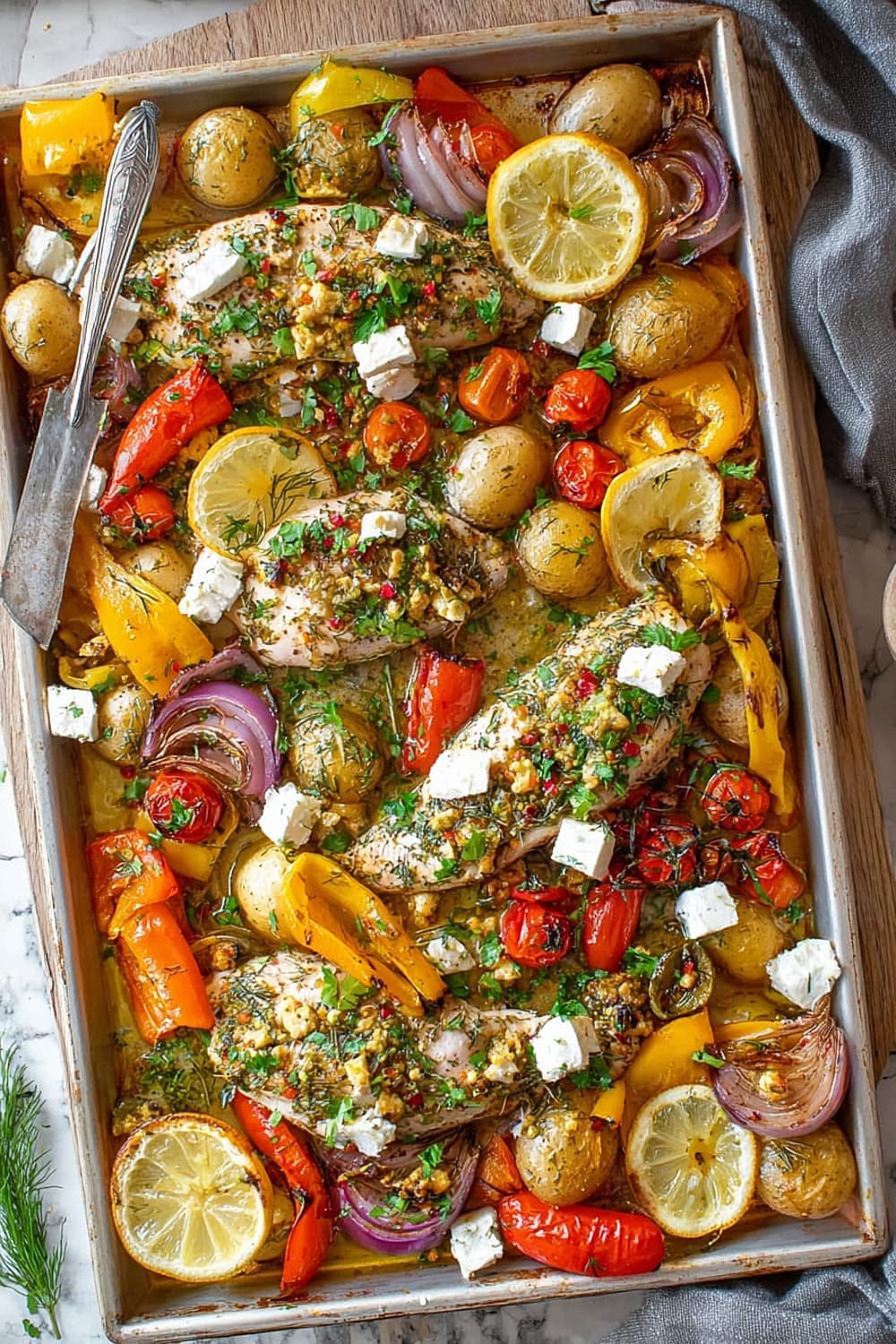
Plus, cleanup is a breeze because there’s literally just one pan to wash – now that’s what I call a win-win situation.
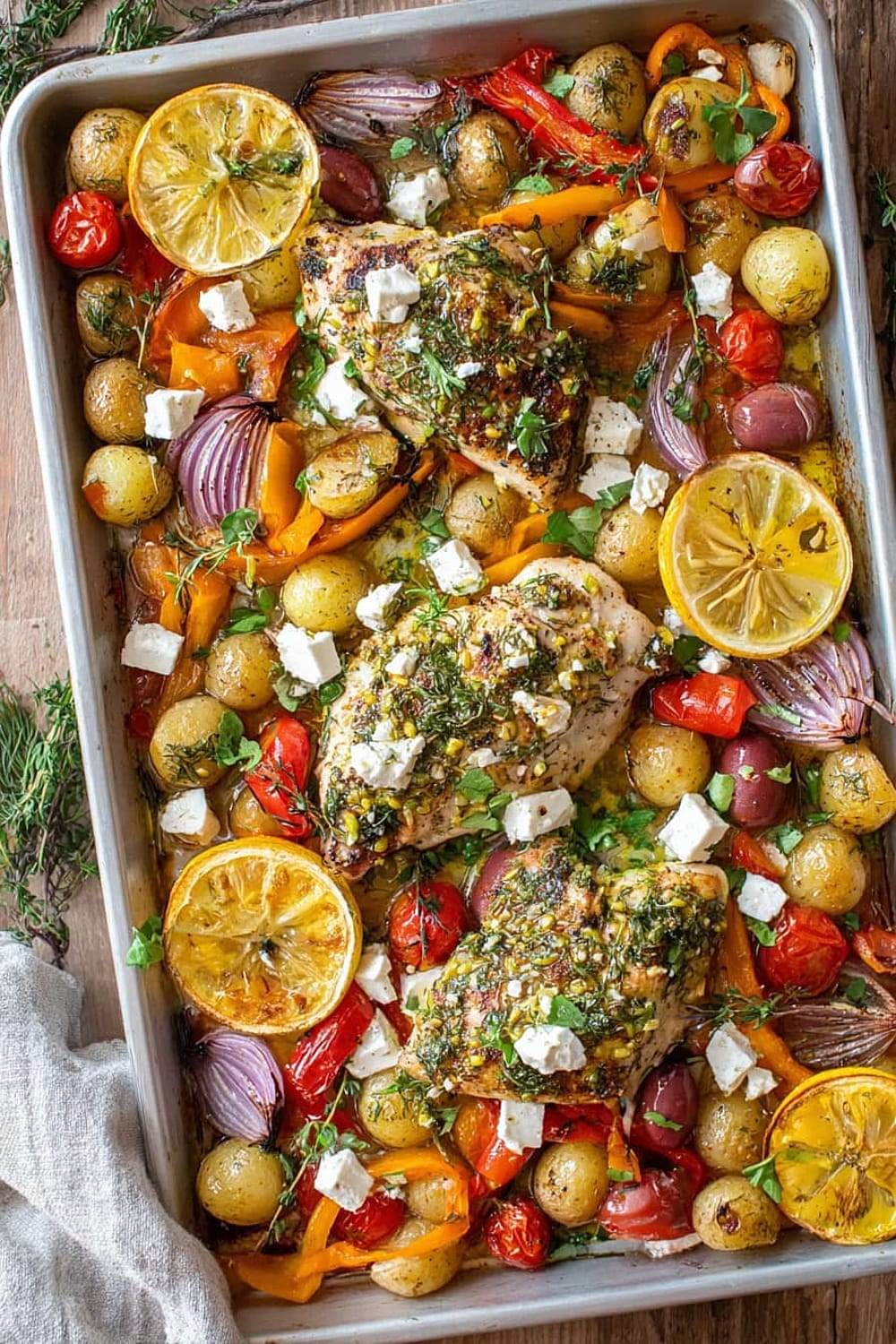
Ingredients
For the Marinade
- ½ cup feta cheese, crumbled
- ¼ cup extra virgin olive oil
- 1 fresh lemon, juiced (about 3-4 tablespoons)
- 2 cloves garlic, minced
- 2 tablespoons fresh parsley, finely chopped
- 1 tablespoon fresh dill, finely chopped
- 1 tablespoon fresh oregano, finely chopped
- 1 tablespoon fresh rosemary, finely chopped
- ½ teaspoon salt
- ½ teaspoon black pepper
- ½ teaspoon sumac (optional but recommended)
For the Sheet Pan
- 1 pound baby potatoes, chopped into ½-inch cubes
- 1½ cups bell peppers, thinly sliced or chopped
- 1 cup cherry tomatoes, whole
- ½ large red onion, thinly sliced
- 2 tablespoons olive oil
- ½ teaspoon salt
- ½ teaspoon black pepper
- 1½ pounds boneless, skinless chicken breast
- 1-2 fresh lemons, sliced into 3 thick rounds each
- ½ cup feta cheese, cut into ¼-inch to ½-inch cubes
Instructions
Prepare the Marinade
- 1 In a liquid measuring cup, combine ¼ cup olive oil, crumbled feta, minced garlic, fresh lemon juice, all chopped herbs, ½ teaspoon salt, ½ teaspoon black pepper, and sumac. Stir thoroughly to combine and set aside to let the flavors meld while you prepare the vegetables.
Prepare the Sheet Pan
- 2 Preheat your oven to 425°F (220°C) and position the rack in the center. Line a large rimmed baking sheet with parchment paper for easier cleanup, though this step is optional.
- 3 On the prepared baking sheet, combine the cubed baby potatoes, sliced bell peppers, whole cherry tomatoes, and sliced red onion. Drizzle with 2 tablespoons olive oil, then sprinkle with ½ teaspoon salt and ½ teaspoon black pepper. Toss everything together with your hands or tongs until all vegetables are evenly coated, then spread into a single, even layer.
Assemble and Bake
- 4 Nestle the chicken breasts directly into the vegetable mixture, making sure they have good contact with the pan for even cooking. Pour the prepared marinade over the chicken, making sure to coat both sides thoroughly. Use your hands to massage the marinade into the chicken for maximum flavor penetration.
- 5 Arrange the lemon wheels around the pan, nestling them between the vegetables and chicken. These will caramelize beautifully and provide bursts of concentrated lemon flavor.
- 6 Bake for 35-40 minutes, rotating the pan halfway through the cooking time for even browning. The chicken should reach an internal temperature of 165°F (74°C) when checked with an instant-read thermometer inserted into the thickest part, and the potatoes should be golden brown and tender when pierced with a fork.
Finish and Serve
- 7 During the last 10 minutes of baking, add the cubed feta cheese to the pan so it warms through but doesn’t completely melt. This timing ensures the feta becomes creamy and slightly softened while maintaining its shape.
- 8 To serve, squeeze the roasted lemon wheels over the entire sheet pan for an extra burst of bright flavor. Top with a generous sprinkle of freshly chopped herbs and adjust seasoning with additional salt and pepper to taste.
Recommended Equipment and Kitchen Tools
Essential Tools (for best results)
- Large rimmed baking sheet – A heavy-duty sheet pan ensures even heat distribution and prevents warping at high temperatures
- Instant-read thermometer – Takes the guesswork out of determining when your chicken is perfectly cooked to 165°F (74°C)
- Liquid measuring cup – Perfect for mixing the marinade and ensures accurate measurements for the olive oil and lemon juice
- Sharp chef’s knife – Makes quick work of chopping vegetables and herbs for consistent cooking
Helpful Upgrades
- Kitchen scale – For more precise measurements, especially helpful if you want to portion the chicken breasts evenly
- Microplane grater – Ideal for zesting lemons if you want to add extra citrus flavor to the marinade
- Silicone spatula – Great for scraping every bit of that flavorful marinade from the measuring cup
- Parchment paper – While not essential, it makes cleanup significantly easier and prevents sticking
Nice-to-Have Options
- Tongs – Perfect for tossing vegetables with oil and seasonings, and for turning chicken if needed during cooking
- Cast iron skillet – If you don’t have a large enough sheet pan, a cast iron skillet can work beautifully for smaller batches
- Aluminum foil – Useful for covering the pan if the vegetables start browning too quickly before the chicken is done
Recipe Variations and Dietary Modifications
Mediterranean Variations
- Greek-style: Add ½ cup Kalamata olives and substitute the sumac with 1 teaspoon dried Greek oregano
- Italian twist: Replace dill and sumac with 2 tablespoons fresh basil and add 2 tablespoons balsamic vinegar to the marinade
- Spanish influence: Include 1 red bell pepper, ½ cup green olives, and 1 teaspoon smoked paprika
Protein Alternatives
- Chicken thighs: Use 2 pounds bone-in, skin-on chicken thighs and increase cooking time to 45-50 minutes
- Fish variation: Replace chicken with 2 pounds firm white fish fillets and reduce cooking time to 20-25 minutes
- Vegetarian option: Double the vegetables and add 1 cup chickpeas and ½ cup pine nuts for protein
Seasonal Vegetable Swaps
- Summer: Add 2 medium zucchini (sliced) and 1 cup yellow squash
- Fall: Include 2 cups butternut squash cubes and 1 sliced fennel bulb
- Winter: Try 2 cups Brussels sprouts (halved) and 1 cup parsnips (cubed)
Dairy-Free Modifications
- Replace feta with ½ cup nutritional yeast mixed with 2 tablespoons tahini for a creamy, tangy flavor
- Add ¼ cup pine nuts for richness and texture
- Increase herbs by 1 tablespoon each to compensate for the missing feta flavor
Nutritional Information and Health Benefits
Key Nutritional Highlights
This sheet pan dinner provides approximately 420 calories per serving, with a well-balanced macronutrient profile of 35 grams protein, 28 grams carbohydrates, and 18 grams healthy fats. The baby potatoes contribute complex carbohydrates and potassium, while the chicken breast delivers high-quality complete protein essential for muscle maintenance and satiety.
Health Benefits of Main Ingredients
The fresh herbs in this recipe are nutritional powerhouses – parsley provides vitamin K and folate, while oregano contains powerful antioxidants like carvacrol that have anti-inflammatory properties. Extra virgin olive oil supplies heart-healthy monounsaturated fats and vitamin E, which work synergistically with the herbs to enhance nutrient absorption. The cherry tomatoes contribute lycopene, a potent antioxidant that becomes more bioavailable when cooked, and the bell peppers provide vitamin C – more than oranges, actually. Feta cheese adds calcium and probiotics while being lower in calories than many other cheeses.
Dietary Considerations
This recipe is naturally gluten-free and provides approximately 6 grams of fiber per serving from the vegetables. The combination of lean protein, complex carbohydrates, and healthy fats makes it suitable for Mediterranean, anti-inflammatory, and balanced eating patterns. Each serving contains about 580mg of sodium, making it appropriate for most dietary needs when balanced with lower-sodium meals throughout the day.
Smart Swaps and Ingredient Substitutions
Herb Substitutions:
- Fresh herbs → 1 tablespoon dried herbs total (use ⅓ the amount of dried vs fresh)
- Sumac → 1 teaspoon lemon zest plus pinch of paprika for similar tangy flavor
- Fresh dill → 1 teaspoon dried dill or 2 tablespoons fresh fennel fronds
Cheese Alternatives:
- Feta cheese → Goat cheese crumbles, ricotta salata, or queso fresco in equal amounts
- Dairy-free option → Cashew cream mixed with lemon juice and nutritional yeast
Vegetable Swaps:
- Baby potatoes → Sweet potatoes, fingerling potatoes, or Yukon Gold potatoes (cut to similar size)
- Bell peppers → Zucchini, eggplant, or yellow squash (adjust cooking time as needed)
- Cherry tomatoes → Grape tomatoes or 1 large tomato cut into wedges
Budget-Friendly Options:
- Chicken breast → Chicken thighs (bone-in, skin-on for more flavor and lower cost)
- Fresh herbs → 2 tablespoons Italian seasoning plus 1 tablespoon fresh parsley
- Extra virgin olive oil → Regular olive oil or avocado oil
Pantry Emergency Substitutions:
- Fresh lemon juice → 2 tablespoons apple cider vinegar or white wine vinegar
- Garlic cloves → 1 teaspoon garlic powder
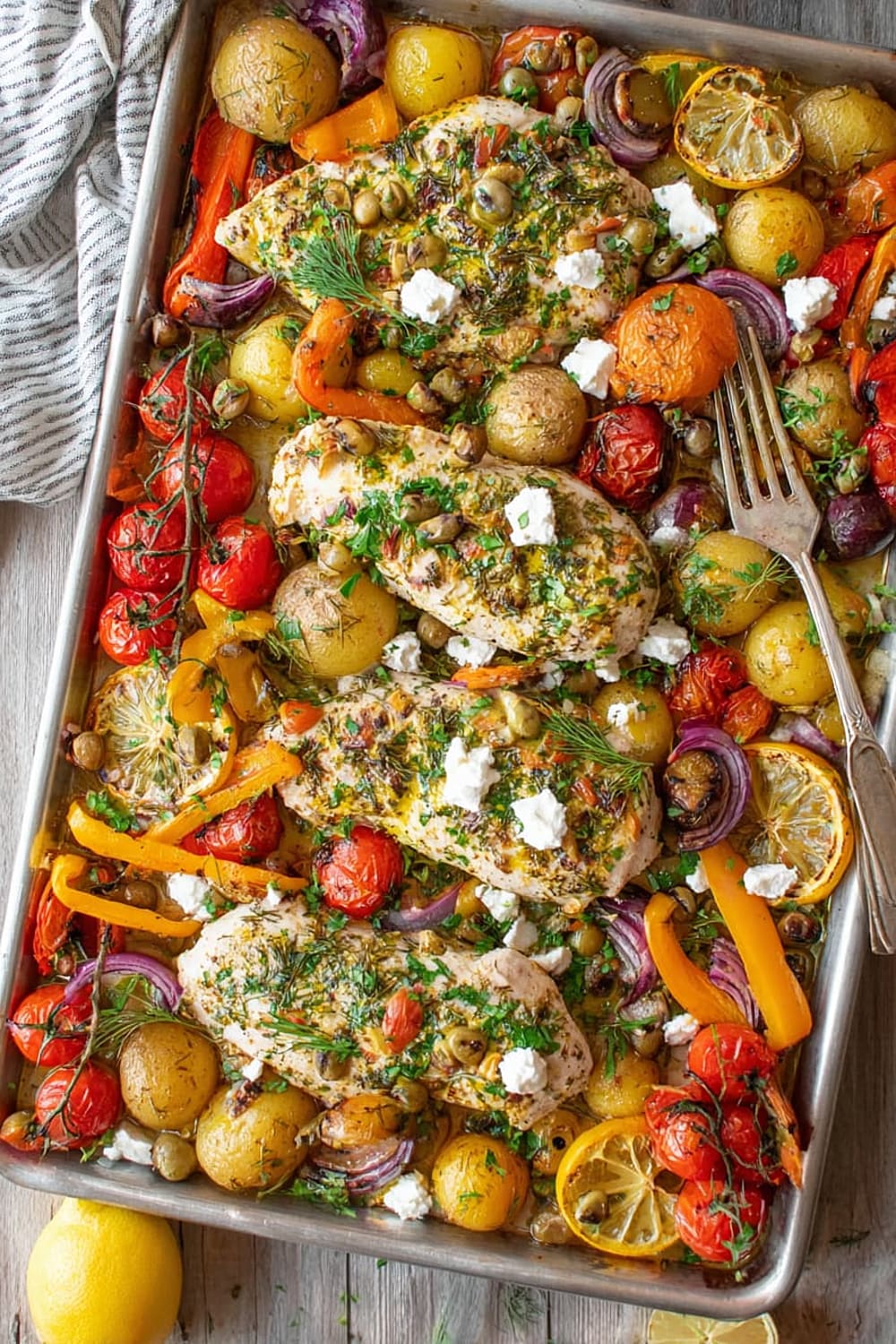
Make It Diabetes-Friendly
Carbohydrate Modifications:
- Reduce potatoes to ½ pound and add 2 cups cauliflower florets to lower total carbs from 28g to approximately 18g per serving
- Substitute completely with turnips or radishes for a very low-carb version (reduces carbs to about 8g per serving)
- Add extra protein by increasing chicken to 2 pounds to help stabilize blood sugar response
Portion Control Strategies:
- Recommended serving size: 1 cup of the mixture provides balanced macronutrients
- Estimated carbs per serving: 18-28 grams depending on potato modification chosen
- Pair with: 2 cups leafy green salad with olive oil dressing to add fiber and volume without significantly increasing carbs
Blood Sugar Management Tips:
- Eat protein first: Start with a few bites of chicken before the vegetables to slow carbohydrate absorption
- Add healthy fats: Drizzle extra olive oil or add ¼ avocado to further slow digestion
- Timing considerations: This meal works well for lunch or early dinner when insulin sensitivity is typically higher
Enhanced Fiber Content:
- Add non-starchy vegetables: Include 2 cups broccoli florets or Brussels sprouts during the last 15 minutes of cooking
- Serve with: Cauliflower rice or zucchini noodles to increase volume and fiber without adding significant carbs
Total Carb Reduction: Modified version contains approximately 18 grams net carbs per serving versus 28 grams in the original recipe.

Perfect Pairing Suggestions
Wine and Beverage Pairings
The bright, herbaceous flavors of this dish pair beautifully with crisp white wines like Sauvignon Blanc, Pinot Grigio, or a Greek Assyrtiko that echoes the Mediterranean flavors. For red wine lovers, a light Côtes du Rhône or Sangiovese complements the herbs without overwhelming the delicate feta. Non-alcoholic options include sparkling water with fresh lemon and mint, or a Greek-style lemonade made with honey and fresh herbs.
Complementary Side Dishes
Serve alongside a traditional Greek village salad with cucumbers, tomatoes, and olives dressed in olive oil and red wine vinegar. Warm pita bread or focaccia makes an excellent vehicle for soaking up the flavorful pan juices. For a lighter option, try tzatziki with cucumber slices or a simple arugula salad with lemon vinaigrette that won’t compete with the main dish’s bold flavors.
Complete Meal Ideas
Start the meal with hummus and vegetables or stuffed grape leaves to build on the Mediterranean theme. For dessert, keep things light with Greek yogurt drizzled with honey and chopped pistachios, or fresh figs with a drizzle of balsamic reduction. This combination creates a cohesive dining experience that transports you straight to the Greek islands.
Seasonal and Occasion Suggestions
This recipe shines during spring and summer when fresh herbs are abundant and you want something satisfying but not heavy. It’s perfect for casual entertaining, family dinners, or meal prep since it reheats beautifully. The colorful presentation makes it ideal for outdoor dining or potluck gatherings where you want to bring something impressive but easy to transport.
Pro Tips and Troubleshooting
Professional Techniques
Pat the chicken completely dry before adding the marinade – this ensures better browning and prevents steaming. Cut vegetables uniformly to ensure even cooking; potatoes should be no larger than ½-inch cubes or they won’t cook through in the allotted time. Don’t overcrowd the pan – if doubling the recipe, use two sheet pans rather than cramming everything onto one, which will cause steaming instead of roasting.
Common Mistakes and Solutions
If your vegetables are browning too quickly while the chicken is still cooking, tent the pan with foil and continue baking. Undercooked potatoes are usually the result of cutting them too large or having an oven that runs cool – increase temperature to 450°F (230°C) if needed. Dry chicken typically means it was overcooked; invest in an instant-read thermometer and remove the pan as soon as it reaches 165°F (74°C).
Storage and Make-Ahead Strategies
This dish keeps beautifully in the refrigerator for up to 4 days and actually improves in flavor as the herbs continue to infuse. Reheat in a 350°F (175°C) oven for 15-20 minutes rather than the microwave to maintain texture. For meal prep, marinate the chicken up to 24 hours ahead and prep all vegetables, storing them separately until ready to cook.
Scaling and Presentation Tips
When doubling the recipe, use two sheet pans and rotate their positions halfway through cooking for even results. For elegant presentation, transfer to a large platter and garnish with fresh herb sprigs and lemon wedges. The pan juices make an excellent natural sauce – simply drizzle over individual portions when serving.